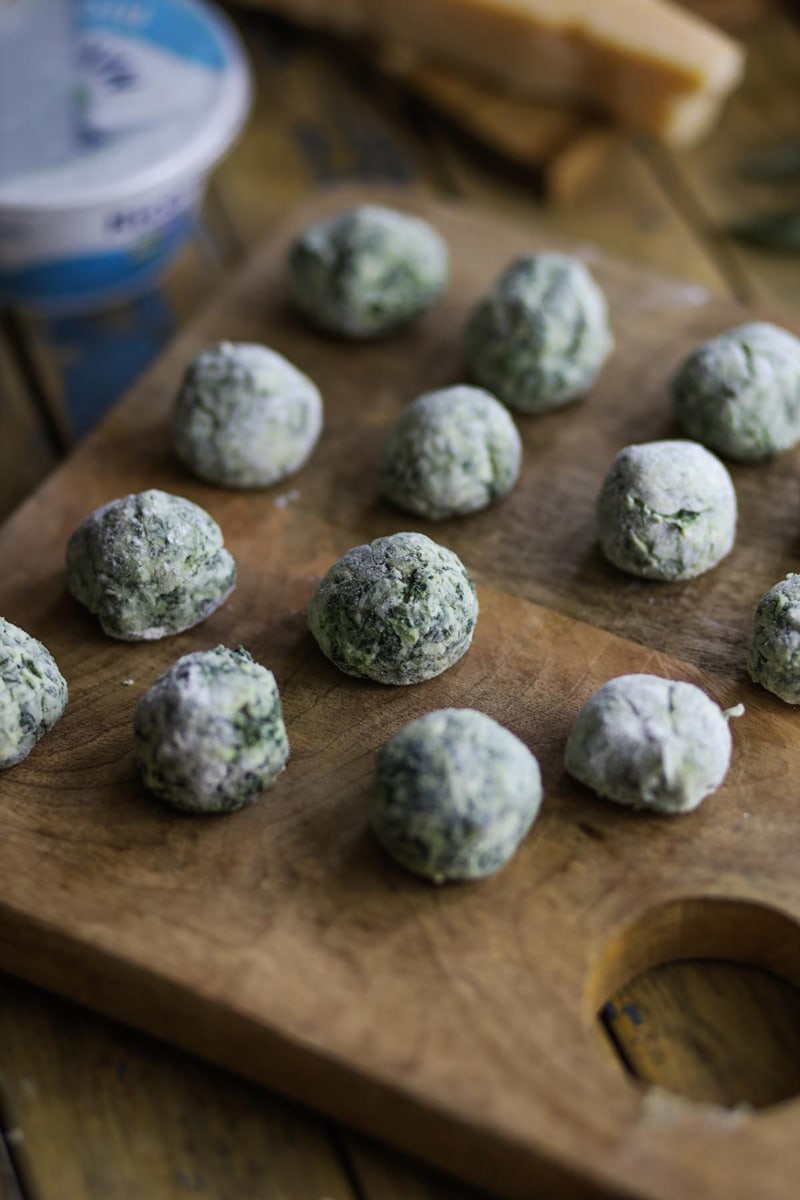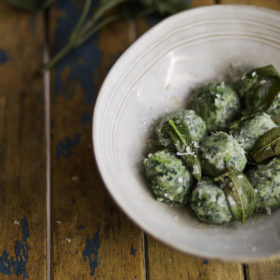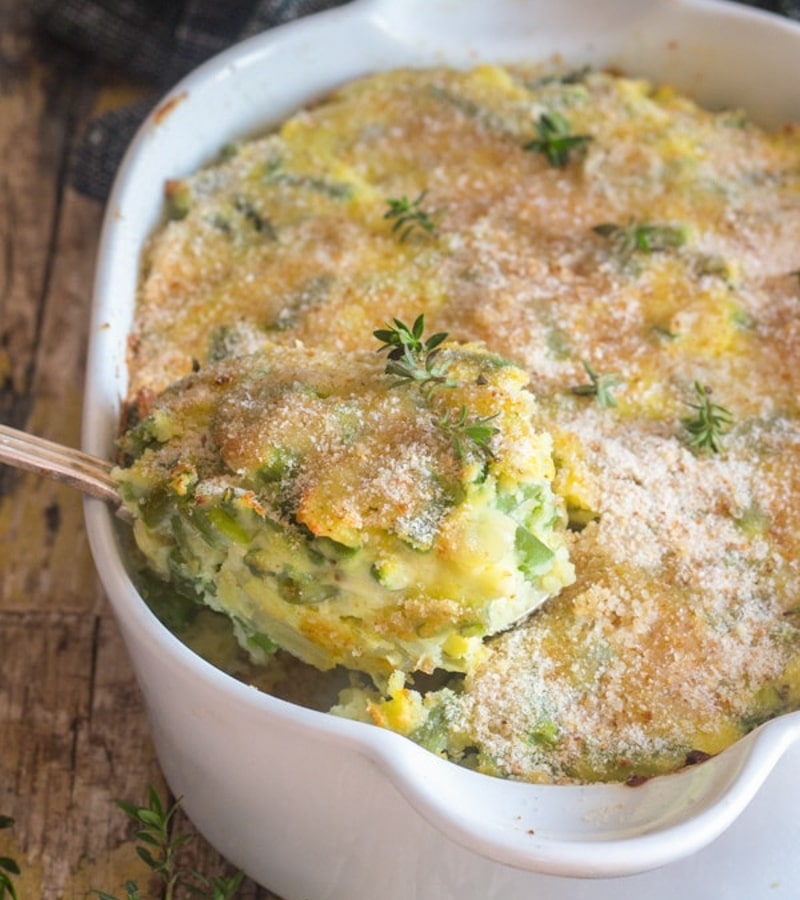Spinach and Ricotta Gnudi
What is Gnudi?
Gnudi is a typical pasta dish of Tuscany, particularly of Siena and Grosseto. Gnudi, similar to potato gnocchi, are dumplings made of ricotta cheese and spinach. These dumplings are called gnudi because they do not have any pastry that covers their filling. In Tuscany, the term gnudo is used to indicate something naked, or bare.
Like many traditional recipes, the gnudi recipe is part of the peasant tradition, and it has been handed down over the years from family to family and each family has its own. It is rare to find gnudi for sale because they are difficult to store easily.
The traditional recipe of gnudi requires the use of butter, but if you prefer a lighter version, you can replace the butter with extra virgin olive oil.

How to cook Gnudi
There are a couple of ways to cook gnudi, depending on how you prefer them and which sauce you want to serve this pasta dish. Let’s explore a couple.
Stir fried
After the gnudi are cooked, they are tossed and stir fried in a large pan in a butter and sage sauce for a couple of minutes to transfer the flavor of the sauce to the gnudi.
Baked
Gnudi pasta can also be baked, and as mentioned previously, they can be made without the use of butter. The latter is certainly lighter and suitable for vegans, while the former is more appetizing because they are baked au gratin. After boiling them and carefully removing any dripping water then place the gnudi in a baking pan, top with abundant Parmigiano-Reggiano cheese and butter. Broil in the oven at high for a few minutes until the cheese and the butter melts and turn brown. Let them rest for a couple of minutes before serving them.
For a spicier flavor, one can add some thyme, marjoram, or bay leaf. Additionally, if you like the spicy flavor, you can sauté the spinach with fresh or ground chili.
How long can you store gnudi?
Since it’s a type of pasta that is difficult to store if fresh, gnudi are usually eaten the same day as they are made. You can prepare them in the morning and consume them for lunch, or if you prepare them in the afternoon, you can have them in the evening. You can freeze gnudi provided that you store them in an airtight freezer container for up to 1 month.

Gnudi with spinach and ricotta cheese
#wprm-recipe-user-rating-0 .wprm-rating-star.wprm-rating-star-full svg * { fill: #343434; }#wprm-recipe-user-rating-0 .wprm-rating-star.wprm-rating-star-33 svg * { fill: url(#wprm-recipe-user-rating-0-33); }#wprm-recipe-user-rating-0 .wprm-rating-star.wprm-rating-star-50 svg * { fill: url(#wprm-recipe-user-rating-0-50); }#wprm-recipe-user-rating-0 .wprm-rating-star.wprm-rating-star-66 svg * { fill: url(#wprm-recipe-user-rating-0-66); }linearGradient#wprm-recipe-user-rating-0-33 stop { stop-color: #343434; }linearGradient#wprm-recipe-user-rating-0-50 stop { stop-color: #343434; }linearGradient#wprm-recipe-user-rating-0-66 stop { stop-color: #343434; }
Ingredients
Ingredients for the dough
- 250 g spinach or chard or similar
- 250 g ricotta cheese
- 40 g Parmigiano Reggiano
- 50 g flour
- 1 egg
- Nutmeg to taste
- Salt and Pepper To Taste
Ingredients for the sauce
- Butter
- A sprig of sage
- A sprig of rosemary
- A sprig of marjoram these are optional ingredients
- Pine nuts
Instructions
Make the Gnudi
- Drain the ricotta well.
- Take the spinach and blanch them in lightly salted water for a few minutes, then pass them quickly in iced water so that the original color is retained, drain well, squeeze them, and wait for them to cool down.
- Once cold, chop them very finely with a knife and place them in a large bowl and add the ricotta cheese, the grated Parmigiano-Reggiano cheese, nutmeg, pepper and salt.
- Add the whole egg, flour and mix everything in such a way that the ingredients combine well and become a homogeneous mixture, should it seem too soft or "wet" (because perhaps the ricotta has not been drained well), you just need to add flour little by little until the softness is less and it becomes more homogeneous.
- At this point you can shape your gnudi, form small balls (about the size of a walnut), roll them in flour and place them in a well-floured tray and space them apart.
- Let them rest in the refrigerator for no more than 20 minutes so that they become more compact and homogeneous.
Make the sauce
- In a saucepan, melt the butter.
- Chop the aromatic herbs and cook them in the saucepan at low heat.
- In another saucepan, toast the pine nuts, and coarsely grind them when toasted.
Cook the gnudi
- In a large pot, add water and salt and bring it to a boil.
- Take the gnudi from the fridge and start cooking them by adding a few gnudi at a time in the pot with the boiling water. They will be cooked once they rise to the surface, then take them out with a skimmer.
- Once all the gnudi are cooked, you can proceed with the seasoning. First, toss the flavored butter, then the pine nuts. If you prefer, you may add some freshly ground pepper and Parmigiano-Reggiano cheese on top, and they are ready to serve!
Notes
Nutrition
What is the difference between Malfatti and Gnudi?
There is another type of pasta that is similar to gnudi, and it’s called Malfatti. In Italian Malfatti means badly done and in fact it refers to a type of pasta from Lombardy that does not have an precise shape, hence the name. Malfatti is a sort of dumpling very popular in Lombardy, especially around Brescia, made with ricotta cheese, spinach and eggs but breadcrumbs is used instead of flour.
Source: Spinach and Ricotta Gnudi




